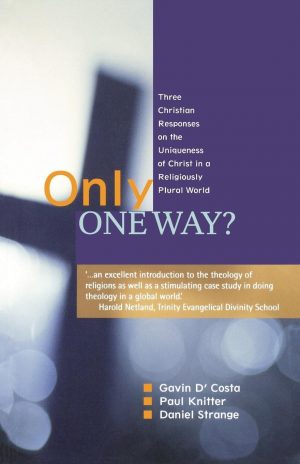Gavin D’ Costa, Paul Knitter, and Daniel Strange compare and contrast three models of how Christianity relates to other world religions in their book Only One Way? D’ Costa is a Catholic theologian and outlines the formal position of the Catholic church, which is inclusivism. Knitter also is a Catholic theologian teaching at a mainline Protestant seminary and presents a model common among liberal theologians, whether Catholic or Protestant: pluralism. Daniel Strange is a Reformed theologian with a Dutch Calvinist bent a model typically called exclusivism, though he rejects that label as denigratory.
D’ Costa summarizes the inclusivist theology of the Catholic church this way:
God through Christ is the cause of all salvation and the Church is Christ’s body on earth, the means by which all grace is mediated. How this grace might be meditated to those outside the Church is an area that is not defined or resolved, but that this grace is mediated to those outside the Church is a certainty. Catholics can be confident that non-Christians might be saved which is the solemn dogmatic teaching on this matter (22).
Knitter does not provide as concise a summary of his model of pluralism, but he outlines three assumptions that shape his thinking, all of which together lead to a denial of the uniqueness of Christianity vis-à-vis other religions. Essentially, then, he argues that different religions can be both revelatory and salvific.
Knitter’s three assumptions concern “how theology works,” “the role of language in theology,” and “two of the most challenging issues that confront Christian faith and life today” (47). For him, theology is “a mutually clarifying and a mutually criticizing conversation between Christian experience and beliefs on the one side and ongoing human experience and understanding of self and the world on the other side” (47–48). Regarding religious language, he believes that “all ‘God talk’ is symbolic” (49); consequently, “if all our words are symbols, then, in general, they should not be taken literally” (50). Finally, he identifies the need for interreligious cooperation and the alleviation of poverty, together with environmental protection, as the most challenging. He says these issues shape “the two criteria by which I will evaluate whether a Christian theology is both meaningful for our contemporary world and faithful to the message of Jesus: is it liberative [poverty/environmentalism] and is it dialogical [interreligious cooperation]?” (51).
Reflecting especially the influence of Dutch Calvinist theologians J. H. Bavinck, Cornelius Van Til, Strange offers this definition of his model:
… from the presuppositions of an epistemologically authoritative biblical revelation (itself presupposed on the self-contained ontological triune God who speaks authoritatively), I will argue that non-Christian religions are essentially an idolatrous refashioning of divine revelation, which are antithetical and yet parasitic on Christian truth, and of which the gospel of Jesus Christ is the ‘subversive fulfillment’ (93).
Strange goes on to advocate as “a holistic, transformative or integral approach to mission that recognizes, on the one hand, the spiritual and social dimensions of sin and idolatry and, on the other,, the scope of the gospel and its entailments to transform individuals, communities and cultures, spiritually, socially, economically, politically, and so on” (132).
Regarding evangelism specifically, he writes: “Given that eternal life is only to be found in the gospel of Christ, and that normatively this comes through the human messenger in this life, in terms of missionary activity, we must speak about the ultimacy of evangelism, that is, the verbal proclamation of the gospel message with the call for faith and repentance in Christ” (134).
Only One Way? unfolds in three parts: In Part 1, each author presents a “position paper” that outlines how his model treats the standard theological loci: “philosophical presuppositions, theological presuppositions, creation, fall, God, Christ, Trinity, salvation, eschaton, dialogue, social justice, and mission” (v). In Part 2, each author responses to the other two authors’ position paper. Finally, in Part 3, each author evaluates the other two authors’ responses. This format allows readers to see how the three models are similar and dissimilar, as well as to evaluate how each model holds up under criticism.
Interestingly, though the Catholic D’ Costa and the Calvinist Strange disagree (sometimes strongly) on various issues, they seem to hold more in common with one another than either holds with Knitter, even though both D’ Costa and Knitter are Catholic. Knitter himself recognizes this, writing: “if we line the three of us up on the spectrum that represents the Christian churches nowadays – with the liberal one on the left, the conservative Dan on the right, and the mainline Gavin in the middle – then it seems to me that the ‘middle’ is much closer to the right than to the left” (199).
The overall benefit of this book is that it shows how different Christian theologies of religion arise from different theological methods and philosophical assumptions. Tradition plays a significant role for D ‘Costa, human experience for Knitter, and biblical revelation for Strange, though to some degree, each author incorporates tradition, experience, and revelation into their argument. The fact that Knitter recognizes his distance from D’ Costa and Strange may point to the conclusion that in reality there are just two positions in a Christian theology of religions, one that recognizes the ultimacy of Christ, and one that does not.
The question on my mind as I turned the last page of this book was whether, in the end, the denial of Christ’s ultimacy even qualifies as a Christian theology. At the very least, it seemed to me to be a theology on the way out the door of the Christian house.
Book Reviewed
Gavin D’ Costa, Paul Knitter, and Daniel Strange, Only One Way? Three Christian Responses on the Uniqueness of Christ in a Religiously Plural World (London: SCM Press, 2011).
P.S. If you liked my review, please click “Helpful” on my Amazon review page.

